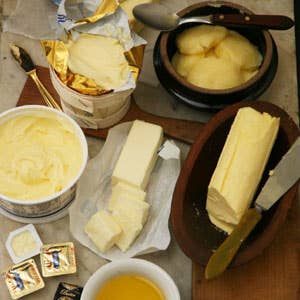
Types of Butter
1. Cultured butter is made from cream in which fermentation—the conversion of milk sugars into lactic acid—has begun to take place. Most butters today are made from cream that's undergone pasteurization, which kills naturally occurring bacteria, so, for this style, lactic-acid bacteria are added to induce fermentation and create a sharper, "cultured" taste. Cultured butter is the preferred style in most of continental Europe.
2. Salted butter, a holdover from the days when salt was added to butter to forestall spoilage, can come in both cultured and uncultured versions. Salted butters, especially those made with sea salt or fleur de sel, make for an emphatically flavored condiment or spread.
3. Pungent-tasting preserved butters such as smen, a Moroccan delicacy, belong to a variety known as fermented butter; they have been allowed to age for anywhere from two weeks to two years and are sometimes seasoned with herbs and spices.
4. Among the most prized but hardest-to-find butter varieties in this country are raw-cream butters, which are made from farm-fresh, unpasteurized cream, an ingredient that's hard to get your hands on if you don't live on a dairy farm.
5. Butter that's been heated so that its water content evaporates and has had its milk solids removed is referred to as clarified butter. This pure, long-lasting butterfat, popular in India (where it is called Ghee), has a high smoke point and serves as a versatile cooking medium, ideal for frying and sauteing.
6 Uncultured butter made from fresh, pasteurized cream is generally referred to as sweet cream butter, which was named after the advent of refrigeration to distinguish it from butter made with soured cream; it is the most common style in North America. Characterized by a smooth, neutral flavor, unsalted sweet cream butter is an excellent choice for baking.
7. In the mid-20th century, Americans' predilection for chilled yet spreadable butter led to the development of whipped butter, which has nitrogen gas whipped into it after it has been churned, so that it will remain soft at low temperatures. Its low density relative to regular butter makes it a poor choice for cooking.
Keep Reading
Continue to Next Story










